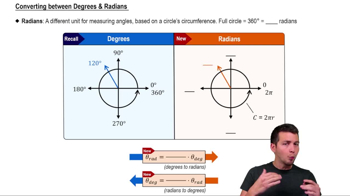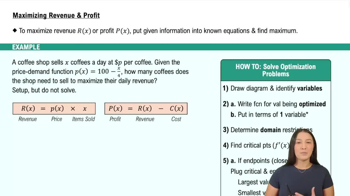Table of contents
- 0. Functions7h 52m
- Introduction to Functions16m
- Piecewise Functions10m
- Properties of Functions9m
- Common Functions1h 8m
- Transformations5m
- Combining Functions27m
- Exponent rules32m
- Exponential Functions28m
- Logarithmic Functions24m
- Properties of Logarithms34m
- Exponential & Logarithmic Equations35m
- Introduction to Trigonometric Functions38m
- Graphs of Trigonometric Functions44m
- Trigonometric Identities47m
- Inverse Trigonometric Functions48m
- 1. Limits and Continuity2h 2m
- 2. Intro to Derivatives1h 33m
- 3. Techniques of Differentiation3h 18m
- 4. Applications of Derivatives2h 38m
- 5. Graphical Applications of Derivatives6h 2m
- 6. Derivatives of Inverse, Exponential, & Logarithmic Functions2h 37m
- 7. Antiderivatives & Indefinite Integrals1h 26m
- 8. Definite Integrals4h 44m
- 9. Graphical Applications of Integrals2h 27m
- 10. Physics Applications of Integrals 2h 22m
5. Graphical Applications of Derivatives
Applied Optimization
Problem 68a
Textbook Question
Particle motion The positions of two particles on the s-axis are s₁ = cos t and s₂ = cos (t + π/4) .
a. What is the farthest apart the particles ever get?
 Verified step by step guidance
Verified step by step guidance1
First, understand that the positions of the particles are given by the functions s₁(t) = cos(t) and s₂(t) = cos(t + π/4). We need to find the maximum distance between these two particles over time.
The distance between the two particles at any time t is given by the absolute value of the difference between their positions: |s₁(t) - s₂(t)| = |cos(t) - cos(t + π/4)|.
Use the trigonometric identity for the difference of cosines: cos(A) - cos(B) = -2sin((A + B)/2)sin((A - B)/2). Apply this identity to simplify |cos(t) - cos(t + π/4)|.
Substitute A = t and B = t + π/4 into the identity: |cos(t) - cos(t + π/4)| = |-2sin((2t + π/4)/2)sin(-π/8)|. Simplify the expression further.
The maximum value of the sine function is 1, so find the maximum value of the expression |-2sin((2t + π/4)/2)sin(-π/8)| by considering the maximum value of the sine terms. This will give the farthest distance the particles can be apart.
 Verified video answer for a similar problem:
Verified video answer for a similar problem:This video solution was recommended by our tutors as helpful for the problem above
Video duration:
6mPlay a video:
Was this helpful?
Key Concepts
Here are the essential concepts you must grasp in order to answer the question correctly.
Position Functions
In this context, the position functions s₁ = cos t and s₂ = cos(t + π/4) describe the locations of two particles along the s-axis as functions of time t. Understanding these functions is crucial for analyzing the motion of the particles, as they provide the basis for calculating distances between them at any given time.
Recommended video:

Relations and Functions
Distance Between Two Points
The distance between the two particles at any time t can be determined by the absolute difference of their position functions: |s₁ - s₂|. This concept is essential for solving the problem, as it allows us to quantify how far apart the particles are at any moment, which is necessary to find the maximum distance.
Recommended video:
Guided course

Converting between Degrees & Radians
Maximization Techniques
To find the farthest distance between the two particles, we need to apply techniques of maximization, often involving calculus. This may include finding critical points by taking the derivative of the distance function and setting it to zero, as well as evaluating endpoints or using the second derivative test to confirm maximum values.
Recommended video:

Maximizing Profit & Revenue

 1:13m
1:13mWatch next
Master Intro to Applied Optimization: Maximizing Area with a bite sized video explanation from Callie
Start learningRelated Videos
Related Practice








